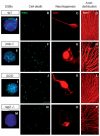Exploring the Origin and Physiological Significance of DNA Double Strand Breaks in the Developing Neuroretina
- PMID: 35742893
- PMCID: PMC9224223
- DOI: 10.3390/ijms23126449
Exploring the Origin and Physiological Significance of DNA Double Strand Breaks in the Developing Neuroretina
Abstract
Genetic mosaicism is an intriguing physiological feature of the mammalian brain that generates altered genetic information and provides cellular, and prospectively functional, diversity in a manner similar to that of the immune system. However, both its origin and its physiological significance remain poorly characterized. Most, if not all, cases of somatic mosaicism require prior generation and repair of DNA double strand breaks (DSBs). The relationship between DSB generation, neurogenesis, and early neuronal cell death revealed by our studies in the developing retina provides new perspectives on the different mechanisms that contribute to DNA rearrangements in the developing brain. Here, we speculate on the physiological significance of these findings.
Keywords: DSBs; NHEJ; Rag2; neurogenesis; neuron somatic mosaicism; recombination.
Conflict of interest statement
The authors declare no conflict of interest.
Figures


Similar articles
-
DNA double-strand breaks as drivers of neural genomic change, function, and disease.DNA Repair (Amst). 2018 Nov;71:158-163. doi: 10.1016/j.dnarep.2018.08.019. Epub 2018 Aug 23. DNA Repair (Amst). 2018. PMID: 30195640 Free PMC article. Review.
-
Genomic rearrangements induced by unscheduled DNA double strand breaks in somatic mammalian cells.FEBS J. 2017 Aug;284(15):2324-2344. doi: 10.1111/febs.14053. Epub 2017 Mar 22. FEBS J. 2017. PMID: 28244221 Review.
-
Imaging Flow Cytometry Quantifies Neural Genome Dynamics.Cytometry A. 2019 Aug;95(8):825-835. doi: 10.1002/cyto.a.23783. Epub 2019 May 7. Cytometry A. 2019. PMID: 31063256 Free PMC article.
-
Ionizing radiation and genetic risks. XVII. Formation mechanisms underlying naturally occurring DNA deletions in the human genome and their potential relevance for bridging the gap between induced DNA double-strand breaks and deletions in irradiated germ cells.Mutat Res. 2013 Oct-Dec;753(2):114-130. doi: 10.1016/j.mrrev.2013.07.003. Epub 2013 Aug 12. Mutat Res. 2013. PMID: 23948232 Review.
-
The role of nonhomologous DNA end joining, conservative homologous recombination, and single-strand annealing in the cell cycle-dependent repair of DNA double-strand breaks induced by H(2)O(2) in mammalian cells.Radiat Res. 2008 Dec;170(6):784-93. doi: 10.1667/RR1375.1. Radiat Res. 2008. PMID: 19138034
Cited by
-
Base excision repair and double strand break repair cooperate to modulate the formation of unrepaired double strand breaks in mouse brain.Nat Commun. 2024 Sep 4;15(1):7726. doi: 10.1038/s41467-024-51906-5. Nat Commun. 2024. PMID: 39231940 Free PMC article.
References
-
- Evrony G.D., Cai X., Lee E., Hills L.B., Elhosary P.C., Lehmann H.S., Parker J.J., Atabay K.D., Gilmore E.C., Poduri A., et al. Single-neuron sequencing analysis of L1 retrotransposition and somatic mutation in the human brain. Cell. 2012;151:483–496. doi: 10.1016/j.cell.2012.09.035. - DOI - PMC - PubMed
Publication types
MeSH terms
Substances
Grants and funding
LinkOut - more resources
Full Text Sources

